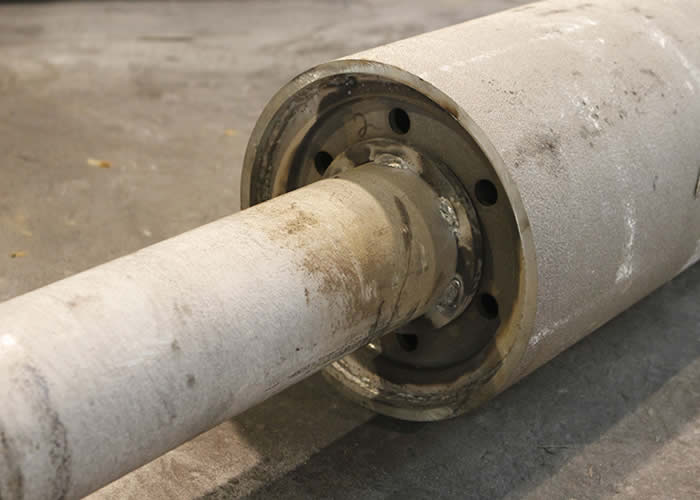
Return rolls are similar to hearth rolls in that tube dimensions and trunnion selection are the same. However, return rolls have an added supporting tube that contacts the belt allowing clearance for the side links.
We produce return rolls in two different ways. The first way has less upfront costs and consists of two short tubes with a tube support at each end of the center tube. The second method uses a two-piece design where one center tube, which supports the larger supporting tube. While somewhat more expensive to produce initially, the benefit of the two-piece design is that, if either tube should be damaged (i.e. broken trunnion or distorted contact tube), we can repair the assembly at less expense than replacing the entire roll.
Any cast-link belt over forty-eight inches wide, and, of course, some forty-eight-inch belts should return on return rolls instead of skid tiles.
In a synchronized furnace, it is preferable to synchronize return rolls with the hearth rolls to prevent excessive stress on the belt.
In the late 1990’s a new design of cast-link furnace was placed into service. This 54”-wide furnace, in the following years, would prove to be the best of this type of equipment yet produced. The unique feature of this furnace was that the rolls, along with the drive drum, were synchronized to turn at the same rate (ft/min). This uniform velocity meant that the belt floated over the rolls; thus, any stress on the pins and links was at an absolute minimum.
The result of this engineering was a furnace that was able to heat-treat 225 million pounds with very little maintenance. When they removed the first belt from service, it was due to alloy attrition, not excessive stretching or loss of pitch. Not only was belt life dramatically increased, but also the ability to control belt tracking increased.
Many existing furnaces can be retro-fitted with synchronized rolls for the hearth, and, in most cases, return rolls can be added in place of skid tiles or rails. The increase in belt life and lower operational maintenance of these upgraded furnaces more than warrant the cost of the rework.
Accuracy is critical in a synchronization project. Therefore, hearth and return rolls should be machined to maintain, plus-or-minus, ten-thousandths of an inch total variation with each other. In addition, it is necessary to minimize any out-of-sync condition because any error could multiply stress by a factor of three. Thus, tubes used in “as-cast” condition with a tolerance of one-sixteenth then the roll circumferences throughout the hearth could vary by three-sixteenths. Over many furnace cycles, this is enough to reduce belt life substantially.
Contact Us today with your heat-resistant, high temperature, cast alloy furnace part needs. Our staff can help you select the correct parts or engineer and then fully cast the high-quality alloy parts for your specific application.
In 1975, Omega Casting's founding mission was to produce alloy castings and assemblies with superior metallurgical and dimensional integrity and to deliver those castings and assemblies in a timely manner to our customers at a competitive cost. (READ MORE)
In the ever-more-competitive global marketplace having a furnace operating at top efficiency is not only important, it is essential. For this reason Omega has developed and pioneered the synchronized drive technology that allows for more furnace load capacity... (READ MORE)
After running several companies, Robert Cutshall founded Omega Castings, Inc. in 1975. It was during a gas shortage and Battle Creek, Michigan was picked as a location due to its natural gas reserves. Locating in Battle Creek assured that there would be fuel to run... (READ MORE)
